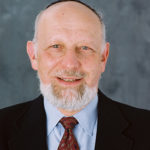You are here: Home » New Outlook » Hot Topics » Transgender Jews and Jewish Law: Redefining the Landscape
Transgender Jews and Jewish Law: Redefining the Landscape
by Jane Calem Rosen
 Joy Ladin always knew she was a girl.
Joy Ladin always knew she was a girl.
In pre-school, Joy, then Jay, only wanted to play with the girls. When they ran away, she was disappointed and confused. They assumed—wrongly—that their classmate only wanted to chase and kiss them. By first grade, Jay was consciously concealing his gender identity—even from his parents.
It was the 1960s. “Parents didn’t want to know. Children then were sent to psychiatric hospitals. I didn’t know about that, but understood there was no one who would understand or help me. I was suicidally depressed for most of my childhood.”
Jay managed to maintain his secret, studying other boys to copy their behavior, and finally found the love he never thought possible, in college, with a woman. They married and had a family. She promised to stay with him as long as he remained a man.
It worked, after a fashion. Until 2007.
Jay Ladin decided it was time to begin to “live as her authentic self,” as Joy, the name she took. She knew it would cost her her marriage and disrupt the lives of their three children. But when the choice became one between life and “killing myself,” she followed Moses’s instruction to the Israelites: “Choose life.”
Today, Joy Ladin, the David and Ruth Gottesman Professor of English at Yeshiva University’s Stern College, is happily remarried to another woman. She does not consider herself to be gay or lesbian; she simply identifies as a transgender woman whose sexual orientation is women, utilizing her own preferred terms.
Television’s “Transparent” and President Donald Trump’s attempt to ban transgender individuals from the US military are two sides of a coin that reflects the visibility in contemporary culture of the complexities of gender and sexual identity. No surprise, then, that the Conservative movement felt a reason to have its say.
 In 2003, the Committee on Jewish Law and Standards (CJLS) of the Rabbinical Assembly published Rabbi Mayer Rabinowitz’s seminal tschuvah, “Status of Transsexuals [sic],” defining transgender identity for the Conservative movement. It set the stage for determining the boundaries and applications of Jewish law for transgender individuals seeking to marry, divorce, convert and be buried, as well as gender-based commandments, like who is obligated to say kaddish or wear a tallis and t’fillin.
In 2003, the Committee on Jewish Law and Standards (CJLS) of the Rabbinical Assembly published Rabbi Mayer Rabinowitz’s seminal tschuvah, “Status of Transsexuals [sic],” defining transgender identity for the Conservative movement. It set the stage for determining the boundaries and applications of Jewish law for transgender individuals seeking to marry, divorce, convert and be buried, as well as gender-based commandments, like who is obligated to say kaddish or wear a tallis and t’fillin.
Gender identity, he postulated, was inextricably tied to a person’s sexual identity, the anatomy assigned at birth. Therefore, Rabbi Rabinowitz wrote, someone who wished to change gender identity must undergo surgical reassignment surgery. Jewish law permits such surgery, Rabbi Rabinowitz argued, to alleviate severe emotional suffering, in this case, from the condition of gender dysphoria. In fact, Rabbi Rabinowitz further asserted, any approach short of a radical procedure to alter one’s sexual anatomy—hormone treatments, for example—did not meet the standard for the public claim to be transgender.
In little more than a decade, Rabbi Leonard Sharzer, MD, who studied with Rabbi Rabinowitz at the Jewish Theological Seminary and was ordained there, revisited the 2003 tschuvah. In the Sharzer version, “Transgender Jews and Halakha,” ratified by the CJLS in June, gender identity is no longer bound up with sexual identity. Gender identity is, rather, determined solely by a person’s declared gender preference, Rabbi Sharzer contended.
“Sexual anatomy defines a person’s sex, which is different from gender. Gender is a social construct: how one dresses, talks, behaves, fits into society,” explained Rabbi Sharzer. “The claim I’m making in the paper is that the gender that we as a society associate with that person is at least as good and arguably much better than assigning gender identity on the basis of anatomy or genetic make-up or other physical attributes. When a person makes a claim about his or her gender, we should accept that.”
 Rabbi Sharzer, who had years of experience as a physician before going to Rabbinical School, continued: “There is some scientific evidence that [gender] identity is present from birth, [although there is] no known determinant, located somewhere in brain, and is [therefore] an inborn attribute.”
Rabbi Sharzer, who had years of experience as a physician before going to Rabbinical School, continued: “There is some scientific evidence that [gender] identity is present from birth, [although there is] no known determinant, located somewhere in brain, and is [therefore] an inborn attribute.”
After making the case that this understanding is superior to the earlier one, the tschuvah goes on to examine the application of halakha governing lifecycle and other gender-based Jewish rituals by answering twelve she’elot, or questions. In the paper’s concluding section, devoted to what Rabbi Sharzer terms practical rabbinics—not halakhic questions, but issues that arise within Jewish institutional life and require solutions that promote inclusivity and respect—he offers perspective and some guidance to Jewish professionals in positions to create appropriate accommodations for public restrooms, locker rooms, overnight camping, and other gender-related circumstances.
His thinking about traditional binary categories of gender and sexual identities evolved, he said, as he sought to better understand the reality of the lived experiences of transgender Jews and how the framework of Jewish law was aligned or misaligned with these. To do that, Rabbi Sharzer reached out to people, like Dr. Ladin, who were directly affected.
“After Len read my memoir (Through the Door of Life: A Jewish Journey Between Genders, University of Wisconsin Press, 2012, also a Women’s League Reads book club pick**), he started thinking in different ways about the policies of the Conservative movement and how they would feel to individual trans people,” Dr. Ladin related. “He became aware that some of the assumptions about trans identity and the reality for trans people and way they experience trans identity are more variable and more personal than he had understood as a doctor. Particularly, he hadn’t had access to trans people’s feelings in relation to Jewish identity and experience and of how transgender Jews think about or experience halakhic policies that affect their lives. Every institution has general policies, but those only have meaning in the context of individuals’ lives. He makes an effort with tremendous integrity to be sensitive to the range of trans people within a halakhic tradition not built to be sensitive to these things, so I am tremendously grateful for his work.”
Another influence on the tschuvah was Rabbi Sharzer’s student at JTS, Rabbi Micah Buck-Yael, a transgender man.
 “Not all trans people require or intend to have surgery,” said Rabbi Buck-Yael. “Not all can access the surgery, and in none of those cases is identity dependent on surgery. A trans person is trans regardless of what they have or have not done to live publicly with a new identity.”
“Not all trans people require or intend to have surgery,” said Rabbi Buck-Yael. “Not all can access the surgery, and in none of those cases is identity dependent on surgery. A trans person is trans regardless of what they have or have not done to live publicly with a new identity.”
Ordained in 2014, the same year he came out as a man, and a lesbian before his transition, Rabbi Buck-Yael was among the first openly gay rabbis accepted into the seminary’s Rabbinical School. He and his wife were married nine years ago in a same-sex Jewish ceremony within the Conservative movement.
Now serving as a chaplain through Jewish Family and Children’s Services in St. Louis, Rabbi Buck-Yael offers a striking example of the evolution of halakhic responses to transgender marriage between 2003 and 2017. In now identifying as a trans man, Rabbi Buck-Yael and his partner would still require a same-sex ceremony to marry, if he did not have sexual reassignment surgery, according to Rabbi Rabinowitz’s earlier thinking. Rabbi Sharzer, however, maintained that kiddushin, the traditional marriage rite for a man and a woman, would today be required for the couple.
Rabbi Sharzer elaborates: “Let’s say today a transgender woman is marrying a cis-gender* man. Both are, from a physical, anatomical sense, male, but one is identifying as a woman. They are married in a traditional kiddushim ceremony. But, a transgender woman marrying a cisgender woman, while anatomically different, have a same-sex ceremony.”
Noting that one difficulty in determining appropriate halakhic responses to trans identity is the binary nature inherent in Jewish law, Rabbi Buck-Yael pointed out the sensitivity Rabbi Sharzer shows to transgender Jews. “He never asks, ‘Are trans people allowed to exist, and what do they have to do for Rabbinic Judaism to accept them?’ Instead, he asks, ‘Given that halakhic categories are binary and people aren’t, how do we address halakhic requirements?’ It’s not about bending the framework, but understanding that sometimes halakhic Judaism is a very ‘embodied’ religion and sometimes…halakha has to get over its assumptions about what that embodiment means.”
The Sharzer tschuvah was ratified by a vote of eleven, with eight abstentions, suggesting some discomfort among members of the CJLS who felt they couldn’t wholeheartedly endorse it.
 “As a Jewish community, we need to offer sensitivity and acceptance to trans and non-gender-conforming individuals. Many of the paper’s practical recommendations are very important and valuable,” said Rabbi Joshua Heller, an Atlanta rabbi on the committee who abstained. “Speaking for myself, I felt it was inappropriate to say ‘no’ and didn’t want to disagree with many of the conclusions of the paper, but [I] couldn’t vote ‘yes’ because I felt that there were some gaps that still needed to be filled in the process, that I would have wanted to see filled.”
“As a Jewish community, we need to offer sensitivity and acceptance to trans and non-gender-conforming individuals. Many of the paper’s practical recommendations are very important and valuable,” said Rabbi Joshua Heller, an Atlanta rabbi on the committee who abstained. “Speaking for myself, I felt it was inappropriate to say ‘no’ and didn’t want to disagree with many of the conclusions of the paper, but [I] couldn’t vote ‘yes’ because I felt that there were some gaps that still needed to be filled in the process, that I would have wanted to see filled.”
Rabbi Heller believes the tschuvah would have gained even broader unconditional support had there been a third round of revisions before the vote, based on greater dialogue with members of the trans community and further internal committee discussion.
For him, one problematic area was a lack of precision in the tschuvah’s response to certain gender-based Biblical commandments, such as the one prohibiting cross-dressing.
“There is a path around this prohibition,” said Rabbi Heller. “One could argue that this commandment should be interpreted so that someone who identifies as a particular gender should dress in a manner appropriate to that gender, rather than their gender assigned at birth; a trans man who dresses as a man is fulfilling, not violating, that commandment. On the other hand, that line of reasoning would still forbid someone who identifies as [cis-]gender male to ‘cross dress’ in female garments or vice versa. That argument needs to be explored in a more fully developed manner.”
Which leads, Rabbi Heller contended, to a “more basic philosophical question: whether these commandments and prohibitions are only suspended for those who meet specific criteria of identity or attraction, so that issues of human dignity and even pikuach nefesh come into play, or whether they are they now effectively nullified for all, including cisgender-identified, heterosexual Jews. The answer to this question is tied to the question of whether we see cisgender heterosexuality as normative and other expressions as non-preferred, but excused, or whether these varying expressions are all considered to be equally legitimate.
“Are we promoting tolerance, or true acceptance?” he wondered.
Rabbi Heller also found Rabbi Sharzer’s redefinition of transgender identity, which essentially forms the core of the tschuvah, lacking. “It’s not for me to tell someone what is or isn’t their gender,” said Rabbi Heller. “But I need to understand the parameters of that; at what point is someone considered to be transgender? If we’re saying we waive a particular commandment because the person is not able to observe it, then we need a better definition of what is transgender. How does one define the point of transition between gender conforming and non-gender conforming, and at what point do commandments no longer apply to these people in a certain category? While Rabbi Sharzer’s answer is self-declaration, I felt we wanted more, even if the answer is not surgery.”
Nonetheless, Rabbi Heller conceded that, “Often, in the Conserative movement, practice gets ahead of legal theory. For example, egalitarian minyanim and having women called up to bimah occurred before the legal theory had evolved to a sophisticated level. That’s the hallmark of the Conservative approach. We first have to understand the real world phenomenon before necessarily fully understanding how the law may be applied.”
 “The theoretical problem is much greater than the practical problem,” offered Rabbi Dr. Elliot Dorff, a leading Conservative scholar and rector and distinguished professor of philosophy at American Jewish University in Los Angeles who voted with the CJLS majority to ratify the tschuvah. “In reality, not a lot of cases will come up, and they will be resolved locally, depending on the particular person and particular group. What reason won’t do, time will.”
“The theoretical problem is much greater than the practical problem,” offered Rabbi Dr. Elliot Dorff, a leading Conservative scholar and rector and distinguished professor of philosophy at American Jewish University in Los Angeles who voted with the CJLS majority to ratify the tschuvah. “In reality, not a lot of cases will come up, and they will be resolved locally, depending on the particular person and particular group. What reason won’t do, time will.”
Rabbi Dorff anticipates that the various arms of the movement—Schechter Day Schools, the Ramah camping movement, USY, Women’s League and Federation of Jewish Men’s Clubs—as well as individual congregations, will deal with creating policies and accommodations that best serve their constituencies.
On the ground, such changes are already occurring.
The experience and perspective related by Rabbi Mitchell Cohen, director of the National Ramah Commission, is instructive.
“We’re very proud of where we are on this,” he declared. “Like in other areas, Ramah camps try to be as inclusive as possible, try to accommodate as many differing needs as we can.”
 In the last several years, he reported, several Ramah camps have been approached by families whose children have gone or are going through transition. “Our camp directors are an amazingly collegial group, which together discusses the appropriateness of various accommodations and communications. There is no need to declare any policy other than our desire for inclusivity. Policies can be misinterpreted; we prefer to deal case by case, considering the needs of each individual child and family.”
In the last several years, he reported, several Ramah camps have been approached by families whose children have gone or are going through transition. “Our camp directors are an amazingly collegial group, which together discusses the appropriateness of various accommodations and communications. There is no need to declare any policy other than our desire for inclusivity. Policies can be misinterpreted; we prefer to deal case by case, considering the needs of each individual child and family.”
Key to the success, Rabbi Cohen maintained, has been balancing the privacy of campers who are transitioning with sensitivity to the needs of other campers and parents, which requires honest communication. In one case, for example, a 13-year-old boy who had spent previous summers in camp as a girl was known by the entire edah. The camp director felt it was important to send an email to the group’s families prior to the start of the camp season.
Channeling Rabbi Dorff, Rabbi Cohen noted that, as cases arise, they will be resolved by each camp’s professional staff and board of directors in accordance with Ramah’s values of inclusivity and acceptance. “Accommodations, communications, discussions with me and with directors of other camps. We are an amazing collegial group. There is no need or desire to declare any policy. Policies can be misinterpreted, if not we’re not dealing with a specific child.”
Jewish culture, by nature, is fully open to interpretation, yet there will remain those who feel that certain rules don’t apply to Jews living outside of conventional gender binaries. One might reason that Conservative Judaism has no need to change or adapt: It upholds the same inclusive, community-based traditions, and those terms may have nothing to do with an individual’s gender identity. Transgender, agender, or non-binary individuals who identify as Conservative, in any location, may not find a place of acceptance as easily. But, whether it is finding oneself at Jewish camp, or serving a leadership role in the clergy, a place within the Conservative Jewish world is indeed possible.
To read the full text of the Sharzer tschuvah, click here.
*While gender identity operates on a spectrum, “cisgender” refers to those who identify with the gender they were assigned at birth.
**Listen to Joy Ladin’s author interview with Women’s League Reads here.









